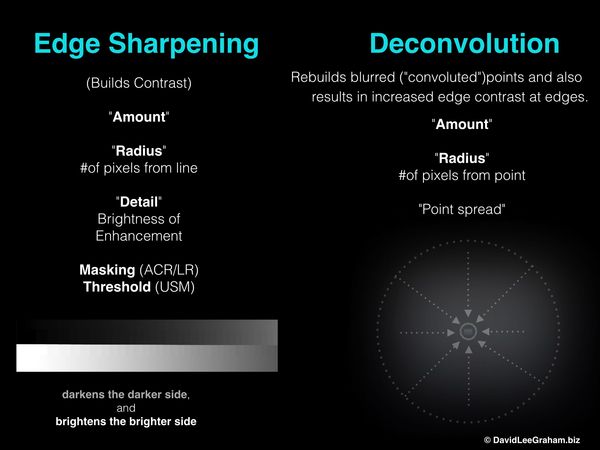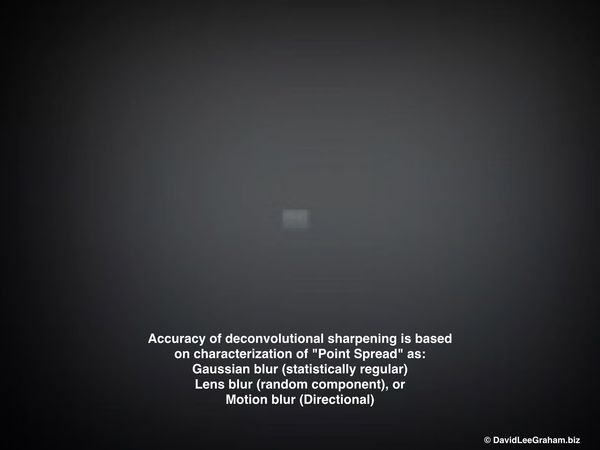Smart Sharpen?
Apr 27, 2015 15:15:22 #
It has been only over the past 5 years that I've given serious attention to use of the "Smart Sharpen" filter of PS. The learning curve has been steep and continues. I'm more-than-a-little curious hearing from those who routinely use Smart Sharpen about the image circimstances/features that suggest to you that the deconvolutional basis of Smart Sharpen may, in your hands, be the most appropriate sharpening mode to use as opposed to the various more frquently recommended "edge sharpeners". (not implying, of course, that Smart Sharpen does not also sharpen "edges").
I might add that "the learning curve continues" I believe mainly because Adobe has likely made frequent improvements in the deconvolutional algorithms of Smart Sharpen during recent years.
Thanks in advance for any and all possible input.
Dave in SD
I might add that "the learning curve continues" I believe mainly because Adobe has likely made frequent improvements in the deconvolutional algorithms of Smart Sharpen during recent years.
Thanks in advance for any and all possible input.
Dave in SD
Apr 27, 2015 15:31:49 #
Deconvolutional algorithms? Say WHAT? Please restate your query in English so ignorant fellas like myself who only had four years of college and two years of graduate school can decipher your arcane intent.
Apr 27, 2015 16:01:38 #
rjaywallace wrote:
Deconvolutional algorithms? Say WHAT? Please restate your query in English so ignorant fellas like myself who only had four years of college and two years of graduate school can decipher your arcane intent.
Sorry rjay, the title "Smart Sharpen?" really states my concern.
" Smart Sharpen" has been among the Sharpening Filters accessed under the "filters" menu of Photoshop for...I don't know how many years.
it operates differently from most other sharpening tools and filters in being a "deconvolutional" sharpener...one that approaches the sharpening job in a totally different manner than do Unsharp Mask filter or the Sharpen Tool for example.
If you use "Smart Sharpen" and can explain when and why you use it, that's what I'm interested in.
There are so many sharpening options that I included the term "Deconvolutional" to more clearly, for those familiar with it, identify how Smart Sharpen works. I certainly wasn't trying to cause confusion.
thanks for letting me know that I did cause confusion in spite of my good intention!
Dave
Apr 27, 2015 20:10:09 #
Well Dave I don't know where to start either. But in two years when I retire and have some time to learn PP. I will get back to you on this. :) But I hope someone will jump in here! I am always ready to learn and make notes for the future.
Apr 28, 2015 06:22:34 #
Maybe this will answer your question....maybe not.
http://photoshoptips.net/2006/03/09/smart-sharpen/
http://photoshoptips.net/2006/03/09/smart-sharpen/
Apr 28, 2015 09:18:39 #
This article shows the difference between using unsharp mask and smart sharpen.
http://masteringphoto.com/the-fine-art-of-digital-printing-the-difference-between-smart-sharpening-and-unsharp-masking/
http://masteringphoto.com/the-fine-art-of-digital-printing-the-difference-between-smart-sharpening-and-unsharp-masking/
Apr 28, 2015 09:40:49 #
rjaywallace wrote:
Deconvolutional algorithms? Say WHAT? Please restate your query in English so ignorant fellas like myself who only had four years of college and two years of graduate school can decipher your arcane intent.
Convolution takes an original signal (for instance the light impinging on a sensor) and combines it with another signal to produce a third measured output signal (for instance the signal output of you photo sensor and camera image processor).
Deconvolution attempts to remove the added signal by applying the inverse of what it guesses was added. If it were totally successful what would remain would be only the original image as received.
Since the programmers who write the deconvolution algorithms do not know exactly what was applied to the original signal, there are options that can be tried by the user to see what produces the best, most pleasing result.
Apr 28, 2015 11:35:00 #
lsimpkins wrote:
Convolution takes an original signal (for instance... (show quote)
Hi, lsimpkins,
For the more specific response to the questioner. .
I'm hoping that the three options of blur with which Smart Sharpens specifically contends may be discussed in the context of the blur in our images can confidently be assessed as of the "lens blur"(more random sort) versus the "Gaussian blur" (mathematically defineable sort). In my experience, "motion blur" seems the most reasonably predicted blur with which to effectively deal.
Here are a couple graphics I've found useful in class to introduce discussion of the two main sharpening approaches.
Thanks again.
Best regards,
Dave in SD
Edge vs. Deconvolutional Sharpening

Deconvolutional Sharpening

Apr 28, 2015 12:06:26 #
Hi Dave,
I suspect that motion blur may be one of the more difficult to correct for by deconvolution due to the various image stability mechanisms employed in lenses and bodies and whether it is on or off. Just a guess, I have no direct knowledge.
I suspect that motion blur may be one of the more difficult to correct for by deconvolution due to the various image stability mechanisms employed in lenses and bodies and whether it is on or off. Just a guess, I have no direct knowledge.
Apr 28, 2015 14:27:00 #
lsimpkins wrote:
Hi Dave,
I suspect that motion blur may be one of the more difficult to correct for by deconvolution due to the various image stability mechanisms employed in lenses and bodies and whether it is on or off. Just a guess, I have no direct knowledge.
I suspect that motion blur may be one of the more difficult to correct for by deconvolution due to the various image stability mechanisms employed in lenses and bodies and whether it is on or off. Just a guess, I have no direct knowledge.
Hi, ls,
in my exprtience if i'm right on the angle of motion, it works like a charm, if i've no clue as to the angle it,s rather tedious (going 180° step-by-tony step until it's found...Then ...it works.)
Dave
Apr 29, 2015 12:41:13 #
Uuglypher wrote:
Hi, ls,
in my exprtience if i'm right on the angle of motion, it works like a charm, if i've no clue as to the angle it,s rather tedious (going 180° step-by-tony step until it's found...Then ...it works.)
Dave
in my exprtience if i'm right on the angle of motion, it works like a charm, if i've no clue as to the angle it,s rather tedious (going 180° step-by-tony step until it's found...Then ...it works.)
Dave
I should have added " yes, it works, unless improvement is only partial because of a secondary and different axis of motion. When that is identified , and accommodated to, the results are even better...unless a third axis...and a fourth axis...rear their heads'
I find it almost always too tedious for my patience and its main benefit is to make me re-assert my resolve to:
Hand hold more steadily,
Choose my subject better in terms of its immobility,and above all...
To use the damned tripod for (almost) every exposure!
Dave
If you want to reply, then register here. Registration is free and your account is created instantly, so you can post right away.





